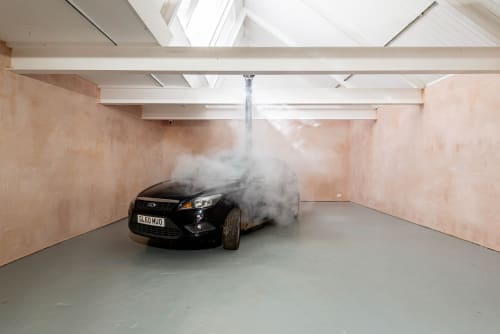Tom Bull creates sculptures, videos, and installations attempt to capture the sensation of lived experience in a fractured contemporary society. His practice navigates a landscape shaped by folklore, rurality, modernity, and ritualism, investigating the tensions and slippages between fiction and representation, violence and sensitivity, truth and mythology. Drawing on a wide range of tools and materials borrowed from architecture, model making, craft, aspirational design, preservation, farming, and forestry, Bull engages in a practice that confronts and manipulates traditions, time periods, locations, lore, and genre.
His most recent works interrogate notions of “country life,” critically addressing issues of land, loss, community, nostalgia, access, labour, and violence. These works are nuanced and complex. Rather than offering resolutions to life’s ambiguities, they highlight them and their resultant anxieties, using these tensions as a visual medium, giving them form and presence.
Having grown up in rural Northamptonshire, Bull's relationship with rural life is central to his work. This engagement is layered: it draws upon the lived experience of nineteen years in the countryside, combined with the critical distance gained from years of living and studying in London. His work emerges from this interplay between the personal and the analytical. He is conscious of the dangers of idealising rural life, which he believes can lead to a romanticised conservatism. As such, his engagement with folk culture retains a sharp criticality. At the same time, Bull challenges the dominant city-centric and hyper-capitalist narratives of urbanisation. His enquiry into contemporary rural issues is marked by a nuanced dualism and a sensitivity to questions of both personal and collective wellbeing.
Currently, Bull is developing a series of sculptural works that reference pastoral paraphernalia, employing historic techniques such as cob—a traditional method combining clay and hay used to build simple shelters. While this technique recalls a pre-industrial past, it remains in use today as a means of constructing accessible housing. Yet Bull notes how such rural practices are now being revived and aestheticised in urban contexts as a way of obscuring deeper anxieties about capitalism, urban development, climate crisis, pandemics, nationalism, and acts of terror. This nostalgic turn, which mines folk customs as a form of escapism, becomes the focus of his critical lens. In response, Bull coats his sculptures with layers of bitumen, treacle, and resin-like substances to disrupt their rural authenticity. These jarring materials act to "modernise" the works, anchoring them firmly in the present and forcing viewers to confront their materiality, placement, ideology, and the complex histories surrounding contemporary rural life.
